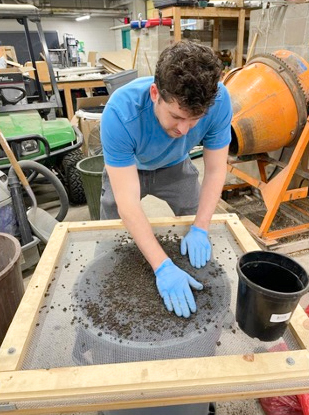
(Photo: Iowa Soybean Association / Joclyn Bushman)
When the heat is on: Microbial soil health
April 1, 2024
By Laura Temple, Soybean Research Information Network
As researchers explore the complexity of soil microbiology, questions arise about the role of soil health in helping crops like soybeans manage environmental stress. For example, if heat stress increases as predicted based on changing climate patterns, what role do native soil microbes play in soybean adaptation to that stress?
Based on conversations and questions raised at a farmer meeting, a team of Iowa State University researchers developed a study through the Iowa Soybean Research Center to explore the impact of high temperatures on soybean growth. ISRC projects match checkoff investments from the Iowa Soybean Association with additional industry funds. ISRC funded this project with additional support from the United Soybean Board, USDA-National Institute of Food and Agriculture and the National Science Foundation through the Cyber-Physical Systems project.
The research team explored how heat stress impacts soybean growth and development at a molecular level — both directly, above ground, and indirectly, below ground. Dinakaran Elango, a research scientist in agronomy at Iowa State University, focused on how heat affects the soil microbiome, which in turn influences soybean growth.
“We are learning how the soil microbiome helps soybeans manage environmental stress,” he says. “This basic research will grow our understanding of soil health and how agronomic practices that improve soil health also improve stress tolerance.”
To discover how heat impacts the soil microbiome, the team planted soybeans in natural soils collected from central Iowa, which are from the clarion soil series with clay loam soil texture, as well as in autoclaved batches of that soil. Autoclaving kills most of the microbes in the soil. The plants germinated and grew in the Enviratron, a climate-controlled research facility at the Iowa State research farm funded by the National Science Foundation that allows manipulation of a wide range of environmental factors. For 45 days, soybeans in both soil types grew under optimal temperatures, 28°C or 82°F, and elevated temperatures, 38°C or 100°F.
Elango and the team surface-sterilized the soybean seeds prior to planting to remove seed microbes. They also minimized exposure to outside factors to accurately monitor the sensitivity of the soil microbiome to heat. At the end of the growing period, he examined differences in soil microbial communities between each soil type and temperature. To do this, he extracted soil DNA to understand what types of bacteria and fungi lived there. He also performed metabolite profiling to understand what these microbes do.
Findings direct next research steps
“We found about 300 different metabolites in the natural soil under both temperatures,” Elango reports.
The team identified potential candidate metabolites and microbes specific to high temperatures. He observed shifts in types of rhizobia, which help soybean roots fix nitrogen. For example, he found more bradyrhizobium in the soils kept at the optimal temperature with native microbes.
“From these types of observations, we plan to explore the functions of specific types of microorganisms and how they help soybeans grow,” Elango says. “Objectives of this research include developing an understanding of key metabolites and root anatomical traits in soybean to manage heat stress.”

He also collected soybean root tissue, to see if the heat and shifts in microbial communities altered how they grow.
“The radius of root pith expands under high temperatures,” he explains. This part of the root stores and transports nutrients to the rest of the plant. “We don’t yet know why that happens, but as we understand what changes in the plant under specific conditions, we can identify practices to support growth and yield.”
However, nodulation efficiency, which includes the number, size and leghemoglobin content of nodules, decreased under the higher temperatures.
Elango notes that this basic research can potentially be leveraged for more in-depth applied research.
“We plan to do a large field-level trial to better understand how crop rotation and management practices like tillage type and cover crops impact soil microbial health under environmental stress like heat, drought and flooding,” he says.
The team submitted a USDA-NIFA grant proposal to expand this work by collaborating with Iowa farmers.
“Identifying links between soil microbial health and agronomic practices under environmental stress will help us understand how to build and maintain resilient soils,” he says. “And, this type of research will help translate the value of different soil types and soil health properties for crops like soybeans growing under stressful conditions.”
Learn more at soybeanresearchinfo.com
Back